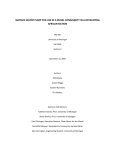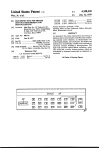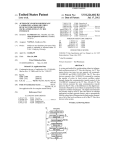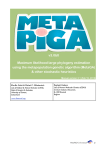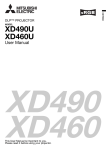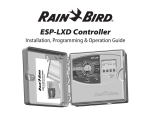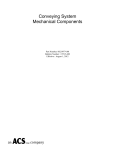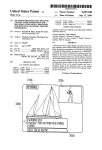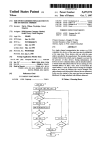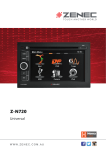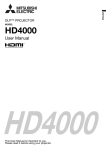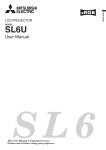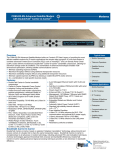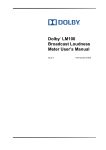Download Tuner control apparatus having tune-by
Transcript
I Umted States Patent [19] [11] Patent Number: Duffield et al. [45] [54] I TUNER CONTROL APPARATUS HAVING Date of Patent: 4,751,578 OTHER PUBLICATIONS my“: lnglfmlzpoblgséhalgy Im'i ' "'5' "" m ‘° ' Mark Fleischmann, “Bold New Gear”, Video Maga ° zine, Apr. 1989, pp. 36-39 and 54-55. ' [73] Assignee: Grundig Service Manual, CUC 2400. RCA Licensing Corporation, Hitachi VT-S625 User Manual, pp. 18-19. PrinCctOn, N-J- RCA VPT 595 Videocassette Recorder Owner’s Man [21] Appl. No.: 334,068 _ [22] Filed: Apr. 6, 1989 [51] “*1, PP- _29-3°__ RCA Dimensla Interconnect and Operations Manual, p. 1Q Int. (31.5 ...................... .. HMN 5/50; H04N 5/44; pn'mary Examiner_john K_ Peng H04N 9/74 [52] Sep. 25, 1990 6/1988 Reiter .......................... ...... .. 358/22 I UNE'BY'LABEL CAPABH‘H Y [75] Inventors: 4,959,720 Attorney, Agent, or Firm-Joseph S. Tripoli; Peter M. US. Cl. ................................. .. SSS/191.1; 358/22; Emanuel; Thomas F_ Lenihan 358/ 194. l; 340/ 825.03; 455/186; 455/603 [58] Field of Search .................. .. 358/22, 191.1, 194.1; [56] [57] ABSTRABT 340/325-03, 825-29; 455/151, 136, 603 A tuning system is provided which allows a user to . References Cited enter text labels associated with respective channels or television programs to be tuned so that, thereafter, a channel or program to be tuned may be selected by the U'S' PATENT DOCUMENTS 4,123,713 10/1978 Wine . . . . . . . . . .. 325/455 user by entering its label. Scheduling of television pro 4’181469 Tanflka ~ - - - ~ ' - ~ - ~ -- 455/136 grams by label is also provided by storing time-related 2/1930 Riggs a1’ data as well as channel~related data and associating 4:356:509 10/1982 Sker103 et ah _ N 358/19“ these data for each television program w1th a user 4,456,925 .. ass/194.1 entered label 6/1984 Skerlos etal. . 4,644,349 2/ 1987 Fujita et a1. . 340/825.25 4,706,121 11/1987 Young ............................... .. 358/ 142 8 8 Drawing Sheets 1M I 7 “mums ' 102 w my ——> mu ' 111 to! roam mm /’°° NO 1?‘ ‘"0 mm "mm m c ‘ MRS".- 1/22 mm "128;" ‘110 m on In: mm! min 124 /112 US. Patent Sep.25, 1990 ' Sheet 1 of 8 4,959,720 100 TUNING VOLTAGE 1 02 TUNER ASSEMBLY 111 lF AMPLIFIER 104 BAND I 109 AND DETECTOR TELEVISION TUNER CONTROLLER VIDEO SIGNAL 1 18 PROCESSOR DATA KEYBOARD } SYSTEM ‘ CONTROL p0 ON SCREEN DISPLAY CIRCUIT IR RECEIVER 116 124 M 112 an 55 an TIMER / 128 DE 120 FIG. 1 T0 DISPLAY SCREEN DRIVERS US. Patent Sep.25‘, 1990 Sheet 3 of 8 4,959,720 12:00 AM STEREO 13 WTHR SLEEP 1:00 AL ANT B CHANNEL MEMORY 13 WTHR ENTER STATION ID: 13 —TH R ‘TEXT ON’ TO SET ID xx CHANNEL ID‘S LEFT PUSH ENTER TO STORE PUSH — TO ERASE ‘FIG. 3d ENTER STATION : - PUSH ENTER TO SEARCH FIG. I 3e US. Patent Sep.'25, 1990 Sheet 4 of 8 m '4°° 4,959,720 FIG. 4 410 DISPLAY LABEL IR cone, YES IN STORE ‘TEXT ON ' ? YES PROGRAMMING CHANNEL MODE? TEXT ENTRY sCREEN 405 NO DISPLAY ' TUNE-BY-LABEL J TEXT ENTRY sCREEN 425 4(35 IS IR CODE A TEXT YES N0 IN TEXT CHARACTER? DIsPLAY ERRoR y MESSAGE ENTRY MODE? 43o YES APPEND NEW ~44‘) CHARACTER TO LABEL No 445 J BEING ENTERED 'TEiiTaEigge?' ? GO TO ~450 NONALPHANUMERIC J DECODING ROUTINES YEs 455 480 No ‘ DISPLAY ERROR DISPLAYED? V 4 —n MESSAGE YES 460 No '5 LABEL ' "WY? 485 YES 490 DoEs THIs CHANNEL ALREADY HAvE A YES LABEL ? 12%; MESSAGE LABEL TUNE CHANNEL HAvING THIS 470 NO I sToRE LABEL 465 ERASE OLD 495 NEW LABEL 498 US. Patent Sep.25, 1990 Sheet 6 of8 4,959,720 600 FIG. 6 UL = HIGHEST LABEL NUMBER 610 LL = 1 615 \_.__ MOVE ALL LABELS AT OR ABOVE CURRENT POSITION UP 1 POSITION 620 CURRENT CENTER LABEL 625 READ CURRENT CENTER LABEL INTO A 630 CURRENT CENTER A<B CURRENT CENTER 1ST CHAR? VALUE + 1 VALUE - 1 635 660 B 2ND CHAR? 640 B ‘ 3RD CHAR? 645 A<B 4TH CHAR? A ' B US. Patent Sep.25, 1990 Sheet 7 018 4,959,720 700 ' UL = HIGHEST LABEL NUMBER 71 0 LL = 1 71 5 GET ‘LABEL NOT FOUND“ W HULL )_ 720 MESSAGE "'2'" ' CURRENT CENTER LABEL READ CURRENT CENTER 725 LABEL INTO A 760 730 ‘ LL = CURRENT : A<B 1ST CHAR, CENTER ' vALuE + 1 A>5 CURRENT CENTER vALuE - 1 735 B 2ND CHAR? 740 B 3RD CHAR? 745 A<B 4TH CHA Fl? 750 US. Patent Sep.25, 1990 FIG. 83 TO SELECT MODE PUSH NUMBER SHOWN 1 CLOCK SET 2 NORMAL PROGRAM 3 DAILY PROGRAM 4 WEEKLY PROGRAM ' s LABEL PROGRAM 6 PROGRAM REv|Ew TO END PUSH PROGRAM FIG. 80 TO SELECT MODE PUSH NUMBER SHOWN “100K SET 2 NORMAL PROGRAM 3 DAILY PROGRAM 4 WEEKLY PROGRAM 5 LABEL PROGRAM s VACATION PROGRAM 1 PROGRAM REvlEw TO END PUSH PROGRAM Sheet 8 On; ‘ 4,959,720 FIG. 8b LABEL PROGRAM PROGRAM 1 CH 0 4 TIME ON 0 6:0 0 PM TIME OFF 0 s :o 5 PM sTART DAY SUN LABEL LA TO END PUSH PROGRAM FIG. 8d “(mg PROGLQAM LABEL 2 LABEL 3 LABEL 4 LABEL LABEL 5 6 cc Cos NY We COL TO END PUSH PROGRAM 4,959,720 1 2 channel in response to the selection of a network’s TUNER CONTROL APPARATUS HAVING TUNE-BY-LABEL CAPABILITY name. Efforts have been made by manufacturers to relate channel numbers to network names. For example, it is known from GRUNDIG television receiver CUC-24-00 to display on the television screen a station identi?ca FIELD OF THE INVENTION This invention relates to the ?eld of tuner controls for tion label (previously entered by the user) whenever a television receivers (including VCRs) and radios. channel is selected. However, the user must still some CROSS REFERENCE TO RELATED APPLICATIONS . how remember which channel is assigned to which 10 network, because channel selection in this system is by This application is related to an application entitled TUNER CONTROL APPARATUS HAVING TUNE-BY-LABEL CAPABILITY AND USING ALPHABETICAL LABEL STORAGE, ?led in the name of David Jay Duf?eld and assigned to the same channel number. Thus, it is desirable that television manufacturers provide remote control handunits which allow viewers to select the channels by name. A tune-by-label system is known from US. Pat. No. assignee as the subject application. 4,706,121 (Young). However, Young provides no means by which the user can enter labels of his own BACKGROUND OF THE INVENTION In the United States there are at least 3 major broad casting networks (e.g. ABC, NBC, and CBS), and also 20 a number of cable service networks (e.g. HBO, ESPN, choosing, either for display or for selecting a channel. In Young, the labels are provided by a broadcaster, as part of a TV schedule transmitted to an in-home tuner controller. The labels, such as HBO and ESPN, are displayed in a menu for selection by the user. Such a Cinemax, etc.), ‘each of which distributes broadcast television programs throughout the country. Many system requires costly and complex circuity. Perhaps, viewers tend to associate their favorite television pro more importantly, it requires the cooperation of broad grams with the networks that carry them. A common 25 casters to dedicate limited spectrum space to the trans problem is that there are so many channels available mission of schedule information. that it is difficult for a viewer to remember which chan nel number corresponds to which network. For exam SUMMARY OF THE INVENTION ple, in some areas of the country a viewer has access to According to the present invention, a tuning system is as many as 40 channels. Thus, tuning by channel num provided which allows a user to enter a text label and ber, although widely used, may not be desirable in these associate it with a particular channel to be tuned. There after, a channel to be tuned may be selected by the user situations. Furthermore, in the hotel/motel environment, the by entering its label. visitor is typically unfamiliar with local channel num In another embodiment of the invention, a tuner con bers. When the visitor wishes to watch a favorite pro 35 troller includes a scheduler which allows a user to enter gram on a known major network, he may have dif? a text label, such as the abbreviation for the name of a television ' program, to be associated with previously ' culty locating the proper local channel owned by, or affiliated with the major network. Compounding this entered programming information. Thereafter, each problem is the fact that it is common practice among cable companies in the United States to remodulate broadcast signals to di?'erent channels of the RF spec trum than those channels which they normally occupy. Unfortunately, this also has the effect of confusing the viewer because, for instance, UHF channel 29 may be remodulated (down converted) to occupy the fre quency space of, for example, VHF channel 9. Thus, even if a viewer happened to know that the FOX Broadcasting Network corresponds to channel 29 (as it does in Philadelphia), the viewer may still have diffi culty locating his desired programs when the signals transmitted by channel 29 are in fact received on cable channel 9. A common solution to this problem is to distribute channel conversion charts to cable subscribers so that time the text label is entered, the television program will be automatically scheduled for future recording (in the case of a VCR), or viewing (in the case of a television set). 45 BRIEF DESCRIPTION OF THE DRAWING FIG. 1 is a block diagram of the tuning portion of a television receiver suitable for implementing the inven tion. FIG. 2 is an illustration of the keyboard of a remote control handunit suitable for implementing the inven tion. FIGS. 3a-3e are illustrations of display screens gener ated by the circuitry of FIG. 1. FIG. 4 is a ?owchart of a program for use with the they may locate the proper cable channel, given the 55 circuitry of FIG. I, for implementing the invention. FIGS. 54 and 5b illustrates a memory arrangement standard broadcast channel, from a printed television produced by implementation of the ?owchart of FIG. schedule. This solution is less than satisfactory because 4. of the relatively large number of available channels. FIG. 6 illustrates in detail a portion of the flowchart Additionally, a problem arises because the channel numbers assigned to the major networks are not the same across the country. For example, the National Broadcasting Company (NBC) broadcasts on channel 4 in New York City, N.Y., on channel 3 in Philadelphia, Pa., on channel 5 in Cincinnati, Ohio, and on channel 11 of FIG. 4. FIG. 7 illustrates in detail another portion of the ?owchart of FIG. 4. FIGS. 8a-8d are illustrations of display screens gen erated by the circuitry of FIG. 1. in Dayton, Ohio. Because television manufacturers can not know in advance in which viewing areas their re ceivers will be operated, it is not possible to preprogram DETAILED DESCRIPTION OF THE DRAWING the tuning system at the factory to select a particular antenna 100 which receives radio frequency (RF) sig Referring to FIG. 1, a television receiver includes an 3 4,959,720 nals and applies them to a tuner assembly 102. Tuner assembly 102 selects and ampli?es a particular RF sig nal under control of a tuner controller 104 which pro~ vides bandswitching signals and tuning voltage signals 4 Operation of the apparatus illustrated in FIGS. 1, and 2, and the display screens illustrated in FIGS. 3a-3e will now be described with reference to FIG. 4. The subject invention makes use of the text programming capabili to tuner assembly 102. ties already present in, for example, the RCA CTC-l40 Tuner assembly 102 converts the received RF signal television receiver referred to above. FIG. 3a illustrates to an intermediate frequency (IF) signal and provides an a STATUS display screen which is displayed by the IF output signal to IF ampli?er and detector 108. IF CTC-l40 television receiver in response to IR signal ampli?er and detector 108 ampli?es the IF signal ap transmitted when a user presses a STATUS key, such as plied to its input terminal and detects the video informa 10 STATUS key 210 of remote control keyboard 200. The tion contained therein. This detected video information STATUS display provides information as to time-of is applied as one input to a video signal switch 109, the other input of which is coupled to a baseband video input terminal 111 to which an external source of video such as a VCR may be connected. Video signal switch 109 has a control input C for receiving a switching day, station tuned, whether or not a “sleep feature” has been enabled, and which of two antenna connectors (ANT B) have been selected for coupling RF signals to the tuner. FIG. 3b illustrates a STATUS display screen modi?ed in accordance with the present invention to display a label (in this case the station call letters control signal. The output terminal of video switch 109 is coupled to one in-put of a video signal processor unit WTHN) immediately below the channel number. The 122, the other input of which is connected to an on label (WTHN) associated with the channel number (13) screen display circuit 124. IF ampli?er and detector 108 20 _ is entered (“keyed-in”) by a user as will be described also detects an audio signal for processing in an audio below. Of course, the label does not have to represent channel (not shown)._ the station call letters but rather could be any alphanu Tuner controller 104 generates the before-mentioned meric label comprising any of one to four characters tuning voltage signals and bandswitching signals in response to control signals applied from a system con 25 trol microcomputer (uC) 110. Microcomputer 110 also generates the switching control signal for video signal representing letters, numbers, or punctuation marks. Thus, a user can enter any convenient label which would aid him or her in selecting a desired channel. The CHANNEL MEMORY display of FIG. 30 is used for entering channel numbers and associated labels puter 110 receives user-initiated commands from an 30 into memory. The CHANNEL MEMORY SCREEN (FIG. 3c) is displayed in response to the activation of infrared (IR) receiver 116 and from a keyboard 118 MENU SETUP key 212 of remote control unit key mounted on the television receiver itself. Microcom switch 109. The terms “microcomputer” and “micro processor” as used herein are equivalent. Microcom board 200. In the illustration of FIG. 3c channel 13 has already had a label WTHR stored for display. The (RAM) 120 for storing channel-related data and sched 35 legend ‘TEXT ON’ TO SET ID at the bottom of the display is an instruction to the user that, if he desires, he uler information, such as, times and channels for future may press TEXT ON key 206 of remote control unit television programs. RAM 120 may be of either the keyboard 200 to enter a text entry mode for adding a volatile or non-volatile type. One skilled in the art will label to the CHANNEL MEMORY display for a par recognize that if volatile memory is utilized that it may be desirable to use a suitable form of standby power to 40 ticular channel, or for changing a label previously en tered. Pressing TEXT ON key 206 causes the genera preserve its contents when the receiver is turned off. tion of the display of FIG. 3d. The television receiver described thusfar is known, for The dash (—-) in the ?rst character position of the example, from the RCA CTC~140 color television re label in FIG. 3d is a prompt character which serves as ceiver chassis manufactured by Thomson Consumer Electronics, Inc., Indianapolis, Ind. The subject inven 45 a cursor to indicate the label position that will be ?lled by the next character to be entered. The display of the tion will now be described in detail. , dash may also alternate with a character from a previ IR receiver 116 receives IR signals transmitted by, ously entered label v(in this case W) to draw even more for example, a remote control handunit 128 having a attention to the character position to be ?lled. The keyboard such as the one shown in FIG. 2 designated puter 110 includes a timer 112, a program memory (ROM) (not shown) and a random access memory 200. Keyboard 200 may include keys 202 for entering 50 legend “xx CHANNEL ID’S LEFT” of FIG. 3d, where xx is actually a number, indicates to the user the the digits 0-9, keys 203 for entering channel up and amount of space remaining in label memory. channel down commands and a key 204 for turning the The relevant portion of the keycode decoding routine receiver on and off. Remote control keyboard 200 may for microcomputer 110 is illustrated in FIG. 4, and is also include a section labelled TEXT having a key 206 (labelled ON) and a key 208 (labelled ENTER), the 55 entered at step 400 from other portions of the keycode decoding routine. The received keycode is examined to operation of which will be described below. Each of the see if it is the TEXT ON code sent in response to the keys in the top three rows, and ?ve keys of the fourth pressing of key 206 of remote control keyboard 200 row have a subscript indicating a second function for its (step 405). If so, a check is made (step 410) as to whether respective key. Pressing TEXT ON key 206 enables channel information is currently being stored in mem these keys to be used for entering characters of the ory 120 (Le. is a CHANNEL MEMORY screen being alphabet, punctuation marks, a space character, and a displayed?). If channel numbers are currently being backspace command. The ?rst function of each of these stored, the program causes the display of a label pro keys (TRK-, TRK+, etc.) which is not directly rele gramming text entry screen (step 415) as illustrated in vant to the subject invention, will not be discussed. Remote control handunit 128 includes therein elec 65 FIG. 3d. If, however, a label is not in the process of being tronic circuitry (not shown) for encoding a signal to be transmitted in accordance with the particular keys stored, it is assumed that the text is being entered for the pressed. purpose of tuning a new channel, and a tune-by-label 5 4,959,720 text entry screen is displayed (step 420) on the display 6 Viewers have become accustomed to tuning systems which operate relatively quickly with little, or no dis screen as illustrated in FIG. 3e. and the routine exited. The next keycode received should be a text character which therefore will cause the program to take the NO cernible difference in speed of tuning between different channel numbers. Therefore, it is desirable to minimize the time required to locate a label in memory, so that the path from decision diamond 405 to decision diamond 425 wherein a check is made to see if the received key code is a text character. If the keycode does correspond overall tuning time is not unnecessarily increased. This to a text character, a decision is made as to whether the becomes more important as the number of stored labels increases. program is in a text entry mode (step 430). If not, an error message is displayed. on the display screen (step 435) and the program is exited normally. If the program is in a text entry mode (step 430), the new character is associated with desired channels occurs relatively infre quently, while a search incident to a channel change occurs with much greater frequency. In view of the appended to the current label being keyed in (step 440) above, it is herein recognized that it is acceptable to It is herein recognized that the programming of labels (or becomes the ?rst character of a new label). decrease speed of programming in order to increase If, on the other hand, the received keycode did not 15 label search speed during a channel change. correspond to a text character (step 425), then the NO Accordingly, as shown in FIGS. 5a and 5b, the pro path will be followed to decision diamond 445. In deci gram portion for the entry of labels produces a memory sion diamond 445, it is determined if the keycode corre arrangement wherein labels are arranged alphabeti sponds to the TEXT ENTER key 208. If not, the cur cally, and wherein each label is right-justified to facili rent routine is exited by way of the decoding routines 20 tate retrieval searches for channel selection. It is noted for non-alphabetical keycodes (step 450). If the TEXT that a three character label, for example, ABC may be ENTER key is decoded (step 445), then a check is made entered by a user as “13450 0""ABC13". Both ofthe above labels to see if the TUNE-BY-LABEL screen is displayed (step 455). If so, the program recognizes that the user has ?nished entering the label, and it begins a search to 25 see if that label exists in memory 120 (step 460). If the label does not exist in memory 120, a “LABEL NOT will 1" "illll'jlml?fd and "and 1" “13ABC'. This prevents user confusion as to the location of the space character, and additionally serves to physically locate the displayed label more toward the right-hand area of the display screen, so as to lessen interference with the picture being displayed. The - labels may be from one to four characters in length. Four character labels FOUND” error message is displayed (step 465). If the are stored in higher memory (i.e. fartherfrom the start of memory) than are label is found in step 460, then the channel correspond three character labels, and so on. Referring to FIG. 5a, thirteen labels 30 and their associated channel numbers are stored in al ing to this label is tuned (step 470). Returning to step 455, if the TUNE-BY-LABEL - phabetical order in a memory 500 in locations 501-513 screen (FIG. 3d) is not currently being displayed, then respectively. A three character label recently entered, is a check is made (step 475) to see if the LABEL PRO shown stored in a “holding” memory location 520 in GRAMMING screen is displayed (FIG. 3c). If not, I preparation for storage. In FIG. 5b newly-entered label then a suitable error message is displayed (step 480). If, 35 KYW has been properly stored in memory location 510. however, the LABEL PROGRAMMING screen were displayed (step 475), then a check is made to see if the current channel being labelled already has a label asso ciated with it (step 485). If so, the old label is erased (step 490), the new label stored (step 495), and_ the rou . tine is exited (step 49B). If the channel had no label (step 485), then the program advances directly to step 495 for storing the new label. In a tune-by-label tuning system such as the one de scribed above, a search of memory for a match with a 45 particular label is an additional step, not required in a “tune by channel number” system, which will increase the overall tuning time when changing channels. That is, in order to ensure that a keyed-in label matches a stored label, a four character comparison between the two must be made. Thereafter, the label must be con verted to data either representing the channel number, the oscillator frequency or the magnitude of the tuning voltage. ‘ Note that the leading space is also an ASCII text char acter (20 Hexadecimal (HEX), or 32 decimal), and so exhibits a value which can be used for comparison. Therefore, while a viewer may consider KYW to be a three character label, in fact, the program treats it as a four character label, by evaluating and comparing the ASCII value of the leading space. The search is performed much more quickly when the labels are stored in alphabetical order than when randomly stored, because once the labels have been arranged in an order, a binary search can be performed. The term “binary search” as used herein means a search in which the label memory area is divided into two parts, one part being rejected on the basis of a compari son with the label being searched. This process is re peated on the accepted part of label memory until the desired label is found. A binary search will be explained by example with respect to FIGS. 5a and 5b. below. As noted above, the short search duration described It is recognized herein that the user-entered label data 55 above comes at the expense of a longer time being re may be stored randomly, for example, in the sequence in quired for storage. Referring again to FIGS. 5a and 5b, which it is entered, or ordered and stored in some logi and to the ?owchart of FIG. 6, note that each of the cal sequence. If the data were to be stored randomly in labels stored in locations 510-513 of FIG. 50 has been the label memory area, and if the searches were to begin read and rewritten to locations 511-514, respectively, in at the start of the label memory area and progress from order to create room to store the new label in location label-to-label, then the duration of the search will vary 510. The ?owchart of FIG. 6 illustrates in detail pro undesirably with the position of a particular label in the gram block 495 (STORE NEW LABEL) of the ?ow memory. That is, if the label searched for is found in the chart of FIG. 4. This portion of the program is entered ?rst location examined, then the search is terminated in at step 600. Comparison location B holds the received the shortest possible time. On the other hand, if the label 65 keycode and corresponds to holding location 520 of searched for is found in the last of the label storage FIG. 5a. Microcomputer 110 keeps a record of the locations, then the search will be terminated in the lon number of labels entered by a user. In step 610, the gest possible time. maximum necessary range of LABEL memory to be 4,959,720 . 7 searched is de?ned by storing the number of labels entered (i.e. the highest location that need be examined) in a memory location designated UL (upper limit), and storing the number 1 (i.e. the lowest label memory loca tion) in a memory location designated LL (lower limit). 8 FIG. 7 illustrates in detail the contents of decision diamond 460 of FIG. 4. This portion of the control program is the binary search algorithm used during the tune-by-label process. Steps 700-760 perform in the same manner as similarly numbered steps in FIG. 6, and If UL is not equal to LL (step 615), then the search has _ their function will not be described again. There are two exits from this routine, 750 which corresponds to not yet converged, and the NO path is taken to step 620, the YES path of decision diamond 460 (i.e. a matching wherein the current center position of label memory 500 is determined by taking the integer portion of the average of the upper and lower limits (i.e. the integer portion of (UL-l-LL)/2). The current center label in memory is read into a location A (step 625), the con tents of which will be compared to the contents of holding location B on a character-by-character basis in steps 630-645. In each of steps 630-645, if the label in memory has a lower ASCII value than the newly en tered label, the A<B path is taken to step 655. In step 655, the current center value +1 is stored in the lower limit memory location (LL). This has the effect _of di viding the label memory area in half by discarding all locations at or below the current center value. The program then loops back to step 615 to see if it has converged, and if not, computes a new center value in step 620. If in step 630-645 a determination is made that the user-entered value is less than the center value in memory, then the center value —l is stored in the upper limit memory location (UL) (step 660). This has the effect of dividing the remaining memory in half by discarding all locations at or above the current center value. The program continues in this manner until it ?nds the label, or until it converges to a condition wherein UL=LL at which point all labels at or above the last upper limit location (i.e. the current value in UL) are moved up (farther from the start) one label location (step 665). This creates space in the proper location in memory to insert the new label (step 670), such that the contents of the label memory will be in ascending alphabetical order. Note that even if the newly entered label were found to exactly match a label already stored in memory (i.e. the A=B path were followed in all of steps 630-645), the program advances to step 665, creates space in label memory and stores it (although the duplicate label will have a different chan label is found in memory), and 775 which corresponds to the NO path from decision diamond 460 (label not found). As noted above, if the label is found, the tuning data associated therewith is read from memory and used in tuning the desired channel. Although in the illustrated embodiment, it is assumed that text characters are encoded as ASCII (American Standard Code for Information Interchange) charac ters, one skilled in the art will recognize that there are other codes which will also perform satisfactorily. It is further noted that modern television monitor/ receivers include baseband video and audio connectors for connecting signals from, for example, a VCR. Ter minal 111 of FIG. 1 is such a video connector, the audio connector is not shown. It is considered within the scope of this invention to allow selection by label for these external connectors. For example, a pair of video in and audio in connectors may be assigned the label VCRl, TAPE, or any other label which is convenient for the user. Upon receiving the baseband selection label controller 110 would cause the selection of the baseband signals in the manner known, for example, from the OTC-140 television receiver mentioned above. The subject invention may also be useful for schedul ing television programs for automatic selection at a future date (for example, timer recording on a VCR). In accordance with this aspect of the invention, in a sched uler mode of operation, a channel will be tuned at a previously programmed time in response to the entering of a label, rather than being immediately tuned in re sponse to the entering of a label. In this embodiment, the labels are associated with television programs (i.e. a particular channel at a particular time), rather than with channel numbers alone. It is known from prior VCR’s, such as the RCA VPT 595 sold by Thomson Consumer Electronics, Inc., Indi nel number associated with it). The ?rst of the duplicate 45 anapolis, Indiana, to store program recording informa labels which is encountered during a binary search will tion which will be maintained rather than erased after be the one which is tuned. This feature was provided recording of the television program so that it might be because in some areas of the country viewers can re ceive the same programming via the same network on accessed automatically on a daily or weekly basis. It is noted, however, that there are favorite television pro two different channels. Thus, the user can assign the 50 grams which may not be programmed for recording in same label to each channel. The label insertion shown in FIGS. 50 and 5b re quired twenty read operations of memory 500 and twenty write operations to memory 500 (i.e. one read operation and one store operation per character and channel number) to clear a label memory location, plus ?ve store operations to store the new label and channel number (i.e. the space character must also be stored in memory). It is recognized that when there are many labels to be stored, and when non-volatile memory such 60 as EEPROM (electrically erasable programmable read only memory) is used (which typically has long memo either the “daily” or “weekly” mode, because the viewer normally watches them without recording them. Nevertheless, occasions can, and do arise in which it is desired to record one of these television programs. The user thus may be forced to once again enter the same programming data, each time he or she wants to record a particular television program, be cause programming data stored in the so-called NOR MAL mode (i.e. other than “daily” or “weekly” modes) is usually erased after the recording event. Operation of the apparatus illustrated in FIGS. 1, and 2, and the display screens illustrated in FIGS. 80 and 8b ry-write times), the storage time may be several sec will now be described. This aspect of the subject inven onds. As noted above, however, the label storage pro tion makes use of the on-screen programming capabili cess is relatively seldom exercised compared to the 65 ties already present in, for example, the RCA VPT 595 videocassette recorder referred to above. number of times the retrieval process is exercised, and therefore the delay in storing a label is an acceptable The scheduler comprises tuner assembly 102, televi compromise to ensure fast search time during tuning. sion tuner controller 104, microcomputer 110, timer 112 9 4,959,720 10 label is found to exactly match a label already stored in memory, then the scheduling information relating to that label is read, and the VCR enabled to record the program at the proper time as determined by timer 112. A further useful feature which is possible with a pro gram-by-label system is illustrated in FIGS. 8c and 8d. The menu of FIG. 8c has had a seventh function choice, VACATION PROGRAM, added to it at position 6, and the PROGRAM REVIEW feature has been relo cated to position 7. If, when the display of FIG. 8c is displayed, a keycode of 6 is received, then the program enters the VACATION PROGRAM mode, and the display of FIG. 8d is generated. In the display of FIG. 8d. all of the label data for six television programs are shown already entered by a user. Each of the labels entered must have previously been associated with tele vision program data by being stored via the LABEL PROGRAMMING mode. If the labels have been previ ously stored, then in response to, for example, the fol and memory 120. The following is a brief explanation of the scheduling of a particular television program. FIG. 8a illustrates a display screen generated by on-screen display circuit 124 in response to he pressing of the PROGRAM (PROG) key 214 of keyboard 200 of re mote control unit 128. The user is instructed to select a number from 1 to 6 corresponding to a desired function. If the user presses key 1, a CLOCK SET mode is en tered. If the user presses key 2, a NORMAL PRO GRAM mode is entered wherein the user may instruct the VCR to record a single program on a date up to a year away. Pressing key 3 causes the scheduling pro gram to enter a DAILY PROGRAM mode wherein the VCR can be instructed to record a program at the same time each day, Monday through Friday. Pressing key 4 causes the scheduling program to enter a WEEKLY PROGRAM mode in which the VCR can be instructed to record a program on a certain day of every week. Pressing key number 5 while the display screen of FIG. 8a is displayed causes the display of the LABEL PRO 20 lowing sequence of keystrokes: PROGRAM, TEXT GRAM screen illustrated in FIG. 8b. Pressing key 6 ON, “V”, “A”, “C”, TEXT ENTER, microcomputer causes a ten second long display of the information 110 will access memory 120, search all labels found in entered for each of the program numbers beginning with the lowest program number (program numbers the VACATION memory area and schedule the re will be explained below) and displaying information 25 cording of the respective television programs in accor dance with the corresponding data located in the LABEL memory area of memory 120. In this way a few entered for each of the next higher program numbers preferred television programs from all those television until all program information has been displayed. In the program entries having labels associated therewith are case illustrated in FIG. 8b, all of the data for LABEL easily selected for recording while the user is away. PROGRAM 1 has already been entered. Note that in addition to the time‘ data and channel number data, 30 In another embodiment of the invention, multiple VACATION mode screens may also be provided with START DAY (rather than START DATE) and each screen having its own label associated therewith. LABEL data are displayed. With respect to START DAY, the following is In such an embodiment, a user would be able to select a noted. It is recognized that most television programs particular group of television program from a number broadcast in “prime time” (evenings from 7:00 35 of such groups, for programming by entering a single label. It is also recognized herein that television program data may be recalled from LABEL memory by using on which a television program is broadcast is more the program number (e. g. the number 1 of PROGRAM, important to the user, in this context, than is the numeri cal date. The label LA which has been entered by a user 40 1), because the numeral 1 is itselfa label. However, such a system would require the user to remember which will be associated with a television program occurring television programs are stored in which numbered pro on the day, time, and channel speci?ed in the PRO gram storage area. It is noted that, if desired, such a GRAM 1 display screen. As noted above, labels can be p.m.-l1:00 p.m.) are scheduled to be broadcast once a week, on the same day at the same time. That is, the day program-by-number system is easily implemented by any series of alphanumeric characters (limited only by memory size) which is convenient for the user to re 45 use of the present invention by merely using the pro Having entered his or her desired label, the user may gram number (e.g. l) as the label. While the embodiment discussed above concerned recording television programs with a videocassette recorder, it is also recognized herein that scheduler quickly select the corresponding television program for functions are sometimes desirable in other television recording, by simply pressing, for example, the follow receiver systems, such as those having display units (commonly referred to as television sets), and in so called home entertainment centers in which information member. In practice, a label comprising up to four al phanumeric characters has been found to be sufficient for providing meaningful labels for a user. ing sequence of keys located on the VCR or on remote control unit 128: PROGRAM key 214, TEXT ON key 206, L key 216, A key 218, and TEXT ENTER key 208. for an AM/FM radio unit may be displayed on a televi Controller 110 will perform a binary search on the 55 sion screen, such as the RCA Dimensia system. The term television receiver as used herein includes both LABEL PROGRAM memory area until it ?nds label VCR’s and television sets because both of those devices LA. Upon ?nding the proper label, controller 110 will receive and process television signals. access the appropriate stored programming data for use What is claimed: in recording the desired television program at the 1. A signal selection system, comprising: proper time. an RF input terminal for receiving a plurality of RF Thus, once a label, and its corresponding day, time, signals; and channel information have been stored in the tuning means coupled to said RF input terminal for selecting a particular RF signal from said plurality LABEL MEMORY area of memory 120, a viewer may program the VCR to record the next occurrence of that program simply by entering its label. As noted above, this relieves the viewer from having to reenter the day, time, and channel information each time the viewer wishes to record that program. When newly entered 65 of RF signals in response to a tuner control signal; means, coupled to said tuning means, for detecting said RF signal to produce a detected baseband video signal; 4,959,720 11 a baseband input terminal for receiving a sgcQnd 12 4. The signal selection system of claim 3 wherein said baseband video signal; labels are displayed on a display screen of a television receiver. 5. As’ al 1 tons stem, com risin : nals for receiving said detected baseband video 5 ‘871 seecl y P 8 selection means having ?rst and second input termi selection means having ?rst and second input termi nals for receiving ?rst and second signals, respec tively, said selection means selecting a particular Signal from Said ?rst and Second signals response signal and Second baseband Signal, IBSPCOtively, said selection means selecting one of said baseband video signals at said ?rst and second input terminals in response to a selection Signal; memory means for storing label data representative 10 of labels comprising at least one alphabetical char 36ml‘, and tuning data associated with respective ones of said RF signals for tuning said RF'signals, wherein one of said labels is associated with said 15 baseband input terminal for selecting said baseband to a selection signal, wherein one of 581d ?rst and second terminals is a baseband input terminal for receiving a baseband video signal; memory means for storing label data representative of labels comprising at least one alphabetical char acter, wherein one of said labels is associated with Said baseband input terminal for Selecting Said base band signal; signal; ' ‘ data entry means for generating said label data under data entry means for generating Said label data and Said "111mg data under use!‘ control; and 20 control means coupled to said data entry means and said memory means for storing said label data and said tuning data in Said memory means during a user control; and control means coupled to said data entry means and said memory means for evaluating said label data and for storing said label data is said memory means during a programming mode, said control means also being coupled to said selection means, pros‘, - g mode’ said control means also being 25 coupled to said selection means, said control means ‘881d control means retrieving said data from said memory means and generating said selection con retrieving said data from said memory means and trol'signal for selecting one of said ?rst and second signals in response to label data input by a user. generating Said SeleCtiOn Control Signal for Select- 6. The signal selection system of claim 5 wherein said ing one of said baseband video signals in response control means is a microcomputer. to label data input by a user. 30 7. The signal selection system of claim 6 further com 2. The signal selection system of claim 1 wherein said . . control means 1s a microcomputer. . . prising on'screen display_ means for generating signals suitable for displaying said labels. 8. The signal selection system of claim 7 wherein said _ 3‘ The slgnal selecnon system of ‘31mm 2 further com‘ labels are displayed on a display screen of a television prising on-screen display means for generating signals 35 receiver, suitable for displaying said labels. * 45 50 55 65 * ‘ ' * UNITED STATES PATENT AND TRADEMARK OFFICE CERTIFICATE OF CORRECTION PATENTNO. ; 4,959,720 DATED 1 September 25, I990 INVENTOR(S) 1 David J. Duffield, et al It is certified that error appears in the above-identified patent and that said Letters Patent is hereby corrected as shown below: On the Title Page, the following should be inserted under [56] References Cited, U.S. PATENT DOCUMENT: -—4,600,9l8 7/1986 Belisomi, et al. . . . . . . . . . . . . . . . . 340/711- and under OTHER PUBLICATIONS: ——NEU N968U, pgs. 45 and 46-—. Signed and Sealed this Fifth Day of May, 1992 Attest: DOUGLAS B. COMER Attesting O?icer Acting Commissioner of Patents and Trademarks
















